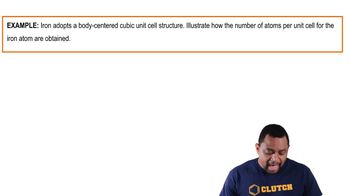Here are the essential concepts you must grasp in order to answer the question correctly.
Body-Centered Cubic (BCC) Structure
The body-centered cubic (BCC) structure is a type of crystal lattice where one atom is located at each of the eight corners of a cube and a single atom is positioned at the center of the cube. This arrangement results in a coordination number of 8, meaning each central atom is surrounded by eight corner atoms. BCC structures are commonly found in metals like iron and chromium, influencing their physical properties.
Recommended video:
Body Centered Cubic Example
Coordination Number
The coordination number refers to the number of nearest neighbor atoms surrounding a central atom in a crystal structure. In the case of the BCC structure, the coordination number is 8, indicating that each atom at the center is in contact with eight corner atoms. This concept is crucial for understanding the packing efficiency and stability of different crystal structures.
Recommended video:
Packing Efficiency
Packing efficiency is a measure of how effectively atoms are packed in a crystal structure, expressed as the ratio of the volume occupied by the atoms to the total volume of the unit cell. In BCC structures, the packing efficiency is approximately 68%, which is lower than that of face-centered cubic (FCC) structures. Understanding packing efficiency helps in predicting the properties of materials, such as density and strength.
Recommended video:

 Verified step by step guidance
Verified step by step guidance


